Analysis of Linguistic Features in Spoken and Written Language
VerifiedAdded on 2021/02/21
|11
|3283
|233
Report
AI Summary
This report provides a detailed analysis of linguistic features in written language, focusing on the text 'Spoken and written language' by Halliday. The report examines the social purpose, genre, text type, and register of the text, highlighting key linguistic features such as spelling, grammar, and punctuation. It explores how these features contribute to effective communication and addresses challenges faced by learners, particularly migrant learners. The analysis covers various aspects, including the use of verbs, nouns, and punctuation, and their impact on clarity and meaning. The report also discusses the stages of text and their functions, the relationship between writer and reader, and the importance of vocabulary and sentence structure. It emphasizes how understanding these linguistic elements is crucial for improving language skills and effective writing. The report also includes an analysis of the text's structure, the use of functional grammar terms, and the psychological aspects of language use, along with examples to illustrate the concepts discussed. The overall purpose of the text is to provide social learning for both younger and migrant learners, focusing on the essential components of written language and the development of effective communication skills. The report concludes by emphasizing the significance of understanding linguistic features for both writing and language teaching.
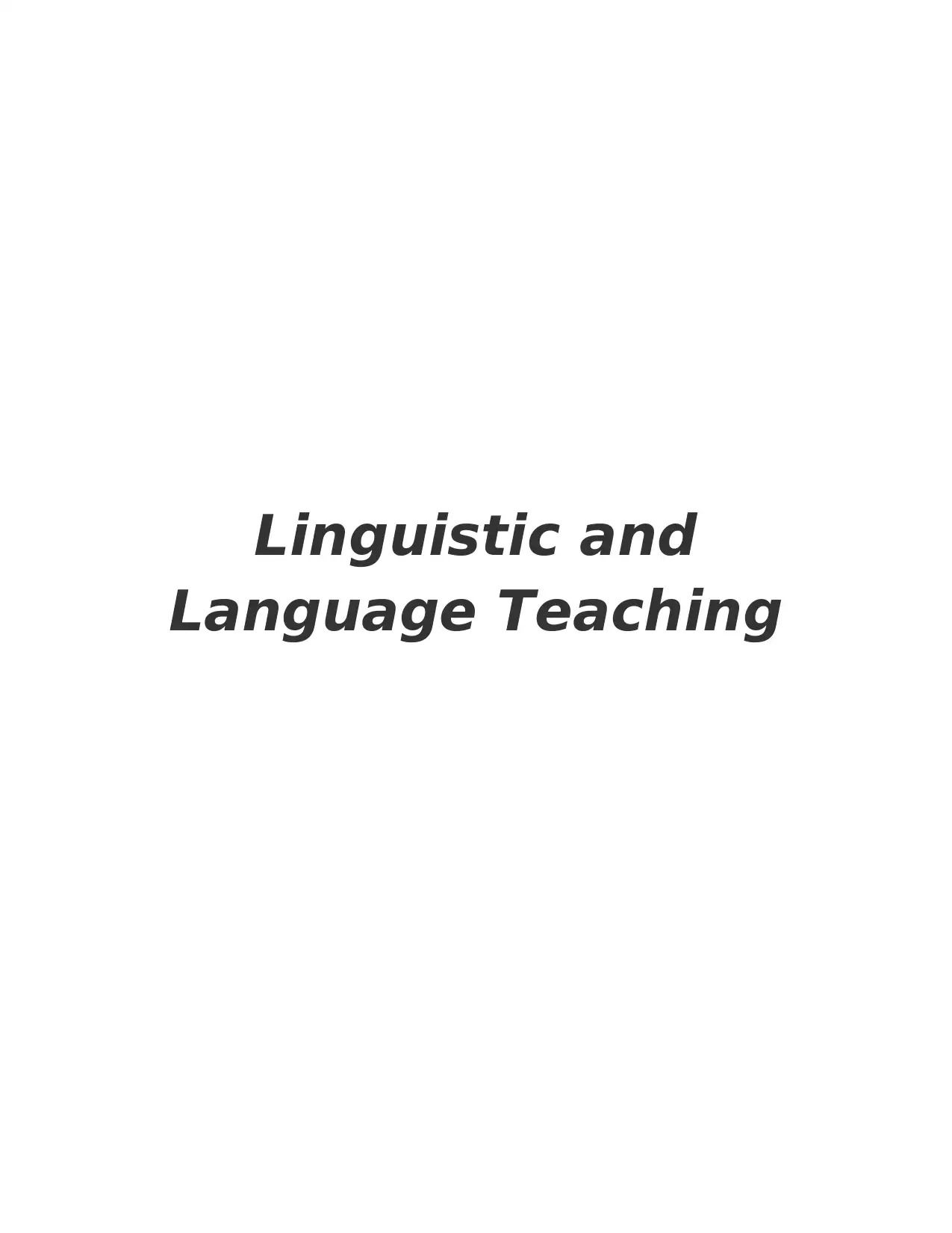
Linguistic and
Language Teaching
Language Teaching
Paraphrase This Document
Need a fresh take? Get an instant paraphrase of this document with our AI Paraphraser
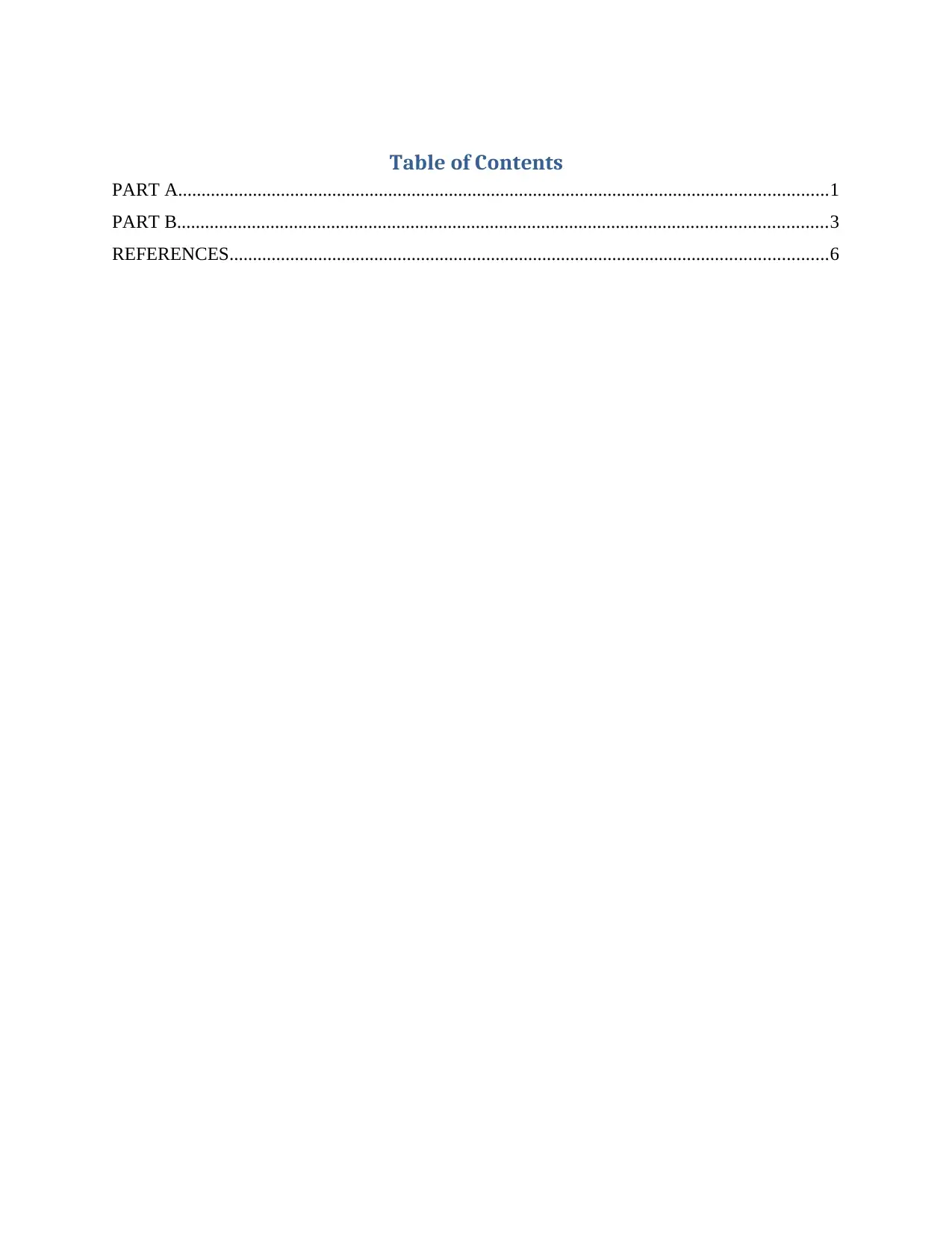
Table of Contents
PART A...........................................................................................................................................1
PART B...........................................................................................................................................3
REFERENCES................................................................................................................................6
PART A...........................................................................................................................................1
PART B...........................................................................................................................................3
REFERENCES................................................................................................................................6
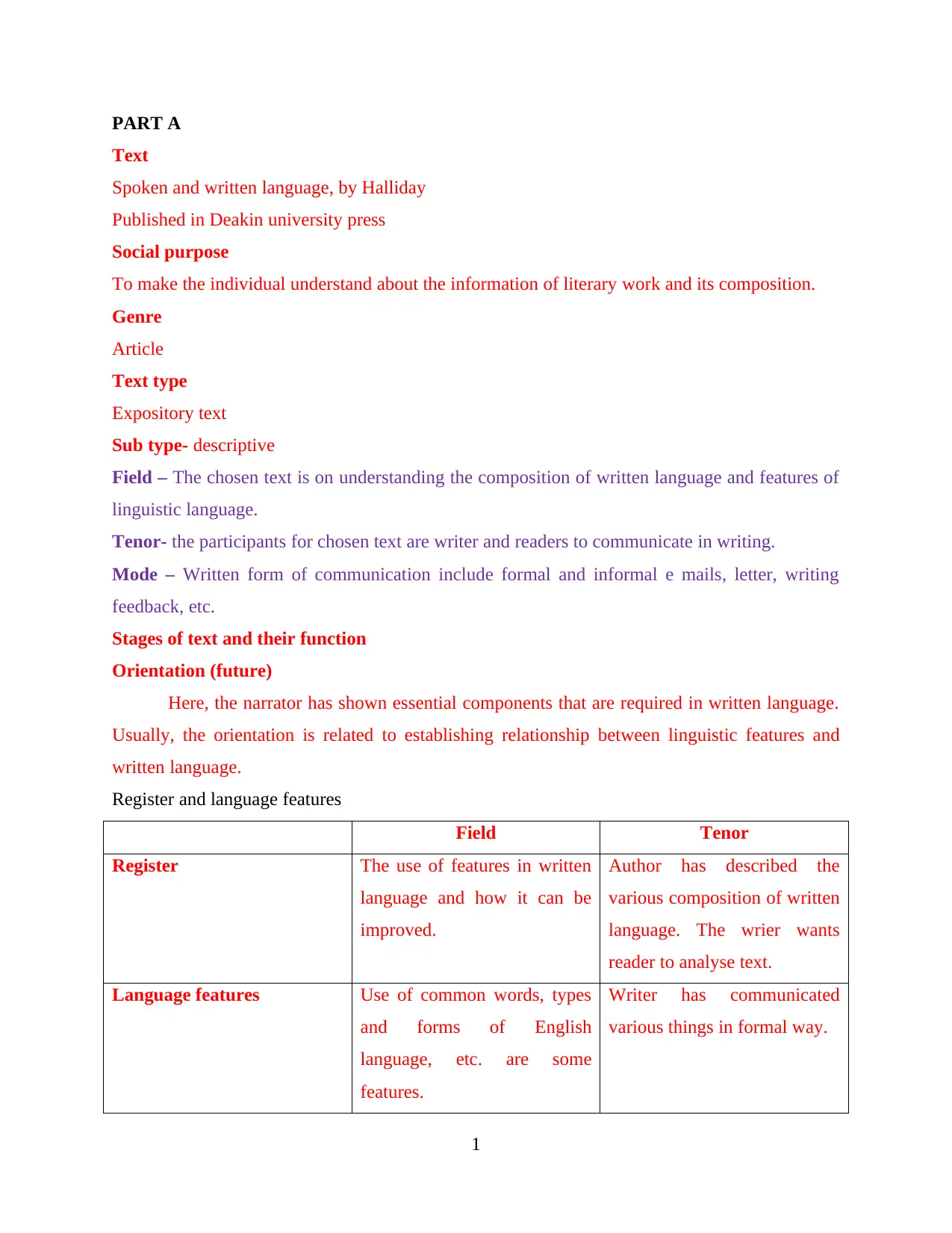
PART A
Text
Spoken and written language, by Halliday
Published in Deakin university press
Social purpose
To make the individual understand about the information of literary work and its composition.
Genre
Article
Text type
Expository text
Sub type- descriptive
Field – The chosen text is on understanding the composition of written language and features of
linguistic language.
Tenor- the participants for chosen text are writer and readers to communicate in writing.
Mode – Written form of communication include formal and informal e mails, letter, writing
feedback, etc.
Stages of text and their function
Orientation (future)
Here, the narrator has shown essential components that are required in written language.
Usually, the orientation is related to establishing relationship between linguistic features and
written language.
Register and language features
Field Tenor
Register The use of features in written
language and how it can be
improved.
Author has described the
various composition of written
language. The wrier wants
reader to analyse text.
Language features Use of common words, types
and forms of English
language, etc. are some
features.
Writer has communicated
various things in formal way.
1
Text
Spoken and written language, by Halliday
Published in Deakin university press
Social purpose
To make the individual understand about the information of literary work and its composition.
Genre
Article
Text type
Expository text
Sub type- descriptive
Field – The chosen text is on understanding the composition of written language and features of
linguistic language.
Tenor- the participants for chosen text are writer and readers to communicate in writing.
Mode – Written form of communication include formal and informal e mails, letter, writing
feedback, etc.
Stages of text and their function
Orientation (future)
Here, the narrator has shown essential components that are required in written language.
Usually, the orientation is related to establishing relationship between linguistic features and
written language.
Register and language features
Field Tenor
Register The use of features in written
language and how it can be
improved.
Author has described the
various composition of written
language. The wrier wants
reader to analyse text.
Language features Use of common words, types
and forms of English
language, etc. are some
features.
Writer has communicated
various things in formal way.
1
⊘ This is a preview!⊘
Do you want full access?
Subscribe today to unlock all pages.

Trusted by 1+ million students worldwide
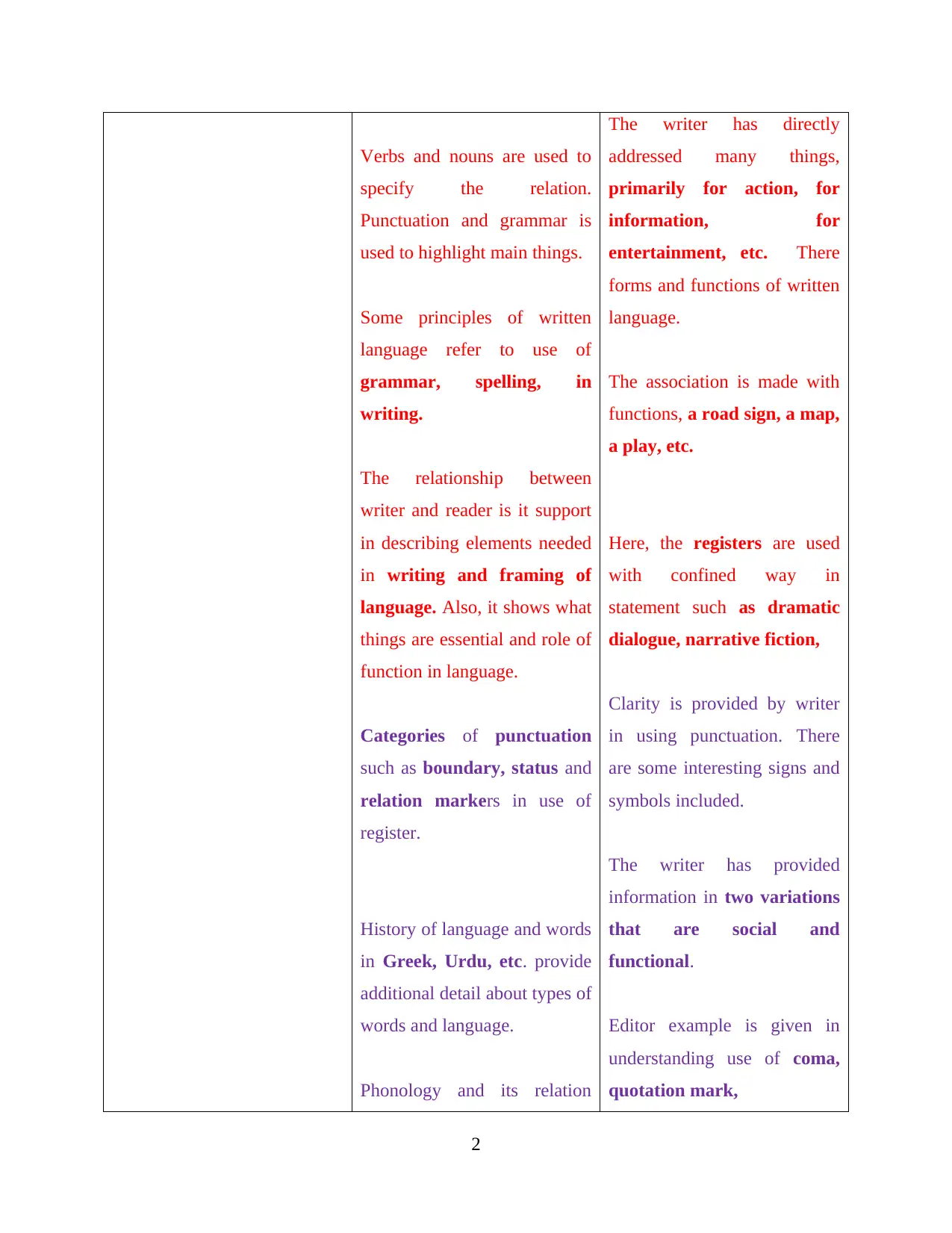
Verbs and nouns are used to
specify the relation.
Punctuation and grammar is
used to highlight main things.
Some principles of written
language refer to use of
grammar, spelling, in
writing.
The relationship between
writer and reader is it support
in describing elements needed
in writing and framing of
language. Also, it shows what
things are essential and role of
function in language.
Categories of punctuation
such as boundary, status and
relation markers in use of
register.
History of language and words
in Greek, Urdu, etc. provide
additional detail about types of
words and language.
Phonology and its relation
The writer has directly
addressed many things,
primarily for action, for
information, for
entertainment, etc. There
forms and functions of written
language.
The association is made with
functions, a road sign, a map,
a play, etc.
Here, the registers are used
with confined way in
statement such as dramatic
dialogue, narrative fiction,
Clarity is provided by writer
in using punctuation. There
are some interesting signs and
symbols included.
The writer has provided
information in two variations
that are social and
functional.
Editor example is given in
understanding use of coma,
quotation mark,
2
specify the relation.
Punctuation and grammar is
used to highlight main things.
Some principles of written
language refer to use of
grammar, spelling, in
writing.
The relationship between
writer and reader is it support
in describing elements needed
in writing and framing of
language. Also, it shows what
things are essential and role of
function in language.
Categories of punctuation
such as boundary, status and
relation markers in use of
register.
History of language and words
in Greek, Urdu, etc. provide
additional detail about types of
words and language.
Phonology and its relation
The writer has directly
addressed many things,
primarily for action, for
information, for
entertainment, etc. There
forms and functions of written
language.
The association is made with
functions, a road sign, a map,
a play, etc.
Here, the registers are used
with confined way in
statement such as dramatic
dialogue, narrative fiction,
Clarity is provided by writer
in using punctuation. There
are some interesting signs and
symbols included.
The writer has provided
information in two variations
that are social and
functional.
Editor example is given in
understanding use of coma,
quotation mark,
2
Paraphrase This Document
Need a fresh take? Get an instant paraphrase of this document with our AI Paraphraser
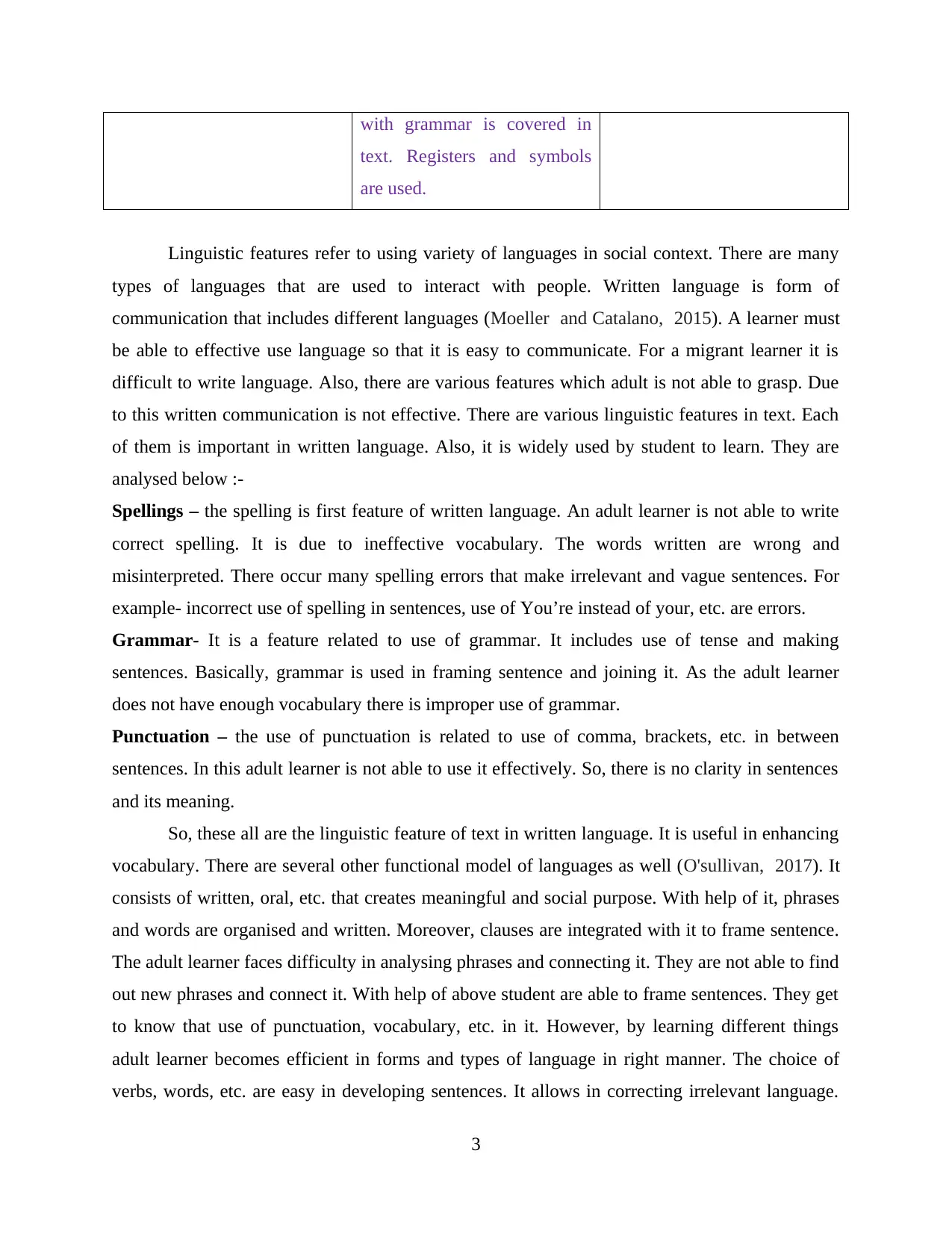
with grammar is covered in
text. Registers and symbols
are used.
Linguistic features refer to using variety of languages in social context. There are many
types of languages that are used to interact with people. Written language is form of
communication that includes different languages (Moeller and Catalano, 2015). A learner must
be able to effective use language so that it is easy to communicate. For a migrant learner it is
difficult to write language. Also, there are various features which adult is not able to grasp. Due
to this written communication is not effective. There are various linguistic features in text. Each
of them is important in written language. Also, it is widely used by student to learn. They are
analysed below :-
Spellings – the spelling is first feature of written language. An adult learner is not able to write
correct spelling. It is due to ineffective vocabulary. The words written are wrong and
misinterpreted. There occur many spelling errors that make irrelevant and vague sentences. For
example- incorrect use of spelling in sentences, use of You’re instead of your, etc. are errors.
Grammar- It is a feature related to use of grammar. It includes use of tense and making
sentences. Basically, grammar is used in framing sentence and joining it. As the adult learner
does not have enough vocabulary there is improper use of grammar.
Punctuation – the use of punctuation is related to use of comma, brackets, etc. in between
sentences. In this adult learner is not able to use it effectively. So, there is no clarity in sentences
and its meaning.
So, these all are the linguistic feature of text in written language. It is useful in enhancing
vocabulary. There are several other functional model of languages as well (O'sullivan, 2017). It
consists of written, oral, etc. that creates meaningful and social purpose. With help of it, phrases
and words are organised and written. Moreover, clauses are integrated with it to frame sentence.
The adult learner faces difficulty in analysing phrases and connecting it. They are not able to find
out new phrases and connect it. With help of above student are able to frame sentences. They get
to know that use of punctuation, vocabulary, etc. in it. However, by learning different things
adult learner becomes efficient in forms and types of language in right manner. The choice of
verbs, words, etc. are easy in developing sentences. It allows in correcting irrelevant language.
3
text. Registers and symbols
are used.
Linguistic features refer to using variety of languages in social context. There are many
types of languages that are used to interact with people. Written language is form of
communication that includes different languages (Moeller and Catalano, 2015). A learner must
be able to effective use language so that it is easy to communicate. For a migrant learner it is
difficult to write language. Also, there are various features which adult is not able to grasp. Due
to this written communication is not effective. There are various linguistic features in text. Each
of them is important in written language. Also, it is widely used by student to learn. They are
analysed below :-
Spellings – the spelling is first feature of written language. An adult learner is not able to write
correct spelling. It is due to ineffective vocabulary. The words written are wrong and
misinterpreted. There occur many spelling errors that make irrelevant and vague sentences. For
example- incorrect use of spelling in sentences, use of You’re instead of your, etc. are errors.
Grammar- It is a feature related to use of grammar. It includes use of tense and making
sentences. Basically, grammar is used in framing sentence and joining it. As the adult learner
does not have enough vocabulary there is improper use of grammar.
Punctuation – the use of punctuation is related to use of comma, brackets, etc. in between
sentences. In this adult learner is not able to use it effectively. So, there is no clarity in sentences
and its meaning.
So, these all are the linguistic feature of text in written language. It is useful in enhancing
vocabulary. There are several other functional model of languages as well (O'sullivan, 2017). It
consists of written, oral, etc. that creates meaningful and social purpose. With help of it, phrases
and words are organised and written. Moreover, clauses are integrated with it to frame sentence.
The adult learner faces difficulty in analysing phrases and connecting it. They are not able to find
out new phrases and connect it. With help of above student are able to frame sentences. They get
to know that use of punctuation, vocabulary, etc. in it. However, by learning different things
adult learner becomes efficient in forms and types of language in right manner. The choice of
verbs, words, etc. are easy in developing sentences. It allows in correcting irrelevant language.
3
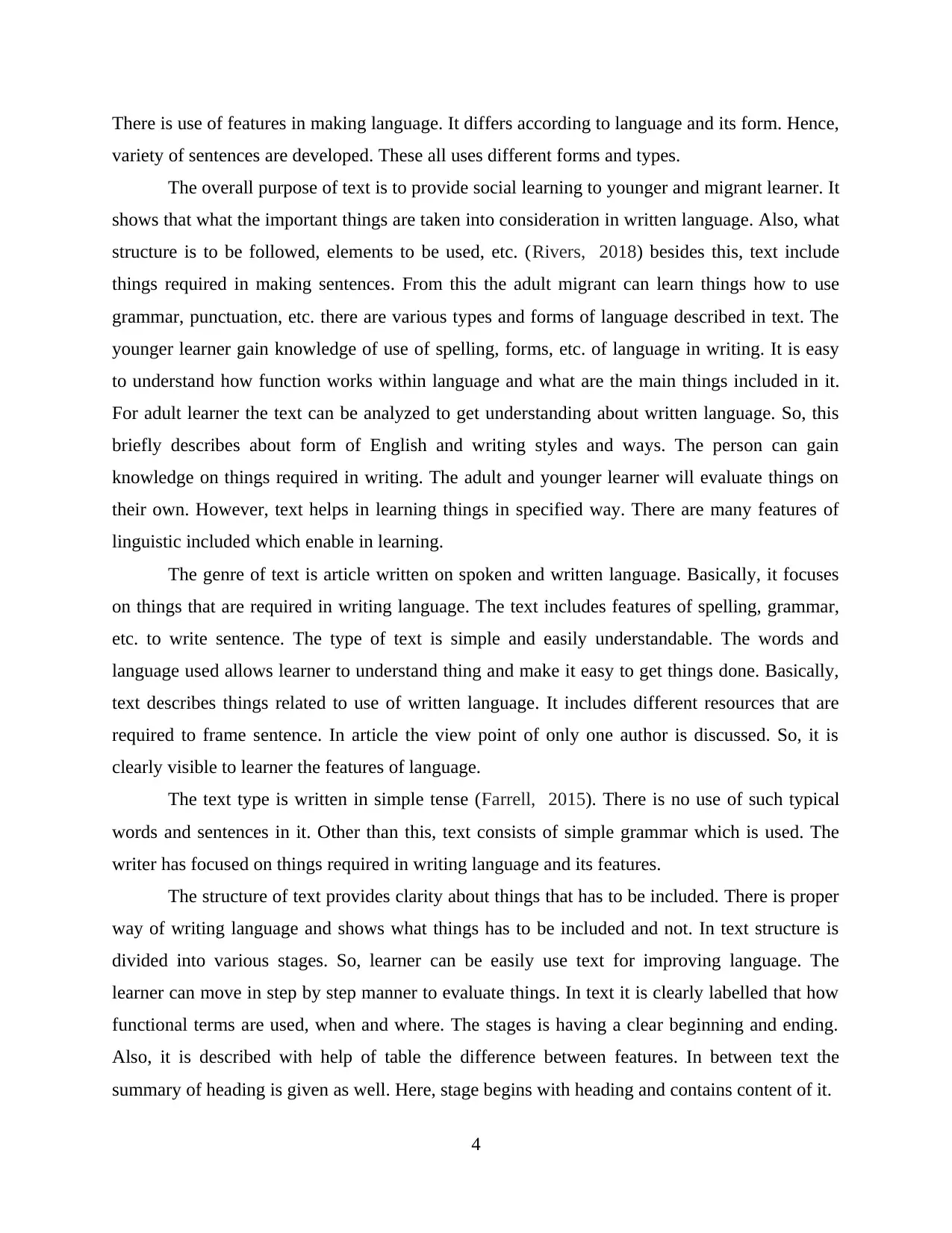
There is use of features in making language. It differs according to language and its form. Hence,
variety of sentences are developed. These all uses different forms and types.
The overall purpose of text is to provide social learning to younger and migrant learner. It
shows that what the important things are taken into consideration in written language. Also, what
structure is to be followed, elements to be used, etc. (Rivers, 2018) besides this, text include
things required in making sentences. From this the adult migrant can learn things how to use
grammar, punctuation, etc. there are various types and forms of language described in text. The
younger learner gain knowledge of use of spelling, forms, etc. of language in writing. It is easy
to understand how function works within language and what are the main things included in it.
For adult learner the text can be analyzed to get understanding about written language. So, this
briefly describes about form of English and writing styles and ways. The person can gain
knowledge on things required in writing. The adult and younger learner will evaluate things on
their own. However, text helps in learning things in specified way. There are many features of
linguistic included which enable in learning.
The genre of text is article written on spoken and written language. Basically, it focuses
on things that are required in writing language. The text includes features of spelling, grammar,
etc. to write sentence. The type of text is simple and easily understandable. The words and
language used allows learner to understand thing and make it easy to get things done. Basically,
text describes things related to use of written language. It includes different resources that are
required to frame sentence. In article the view point of only one author is discussed. So, it is
clearly visible to learner the features of language.
The text type is written in simple tense (Farrell, 2015). There is no use of such typical
words and sentences in it. Other than this, text consists of simple grammar which is used. The
writer has focused on things required in writing language and its features.
The structure of text provides clarity about things that has to be included. There is proper
way of writing language and shows what things has to be included and not. In text structure is
divided into various stages. So, learner can be easily use text for improving language. The
learner can move in step by step manner to evaluate things. In text it is clearly labelled that how
functional terms are used, when and where. The stages is having a clear beginning and ending.
Also, it is described with help of table the difference between features. In between text the
summary of heading is given as well. Here, stage begins with heading and contains content of it.
4
variety of sentences are developed. These all uses different forms and types.
The overall purpose of text is to provide social learning to younger and migrant learner. It
shows that what the important things are taken into consideration in written language. Also, what
structure is to be followed, elements to be used, etc. (Rivers, 2018) besides this, text include
things required in making sentences. From this the adult migrant can learn things how to use
grammar, punctuation, etc. there are various types and forms of language described in text. The
younger learner gain knowledge of use of spelling, forms, etc. of language in writing. It is easy
to understand how function works within language and what are the main things included in it.
For adult learner the text can be analyzed to get understanding about written language. So, this
briefly describes about form of English and writing styles and ways. The person can gain
knowledge on things required in writing. The adult and younger learner will evaluate things on
their own. However, text helps in learning things in specified way. There are many features of
linguistic included which enable in learning.
The genre of text is article written on spoken and written language. Basically, it focuses
on things that are required in writing language. The text includes features of spelling, grammar,
etc. to write sentence. The type of text is simple and easily understandable. The words and
language used allows learner to understand thing and make it easy to get things done. Basically,
text describes things related to use of written language. It includes different resources that are
required to frame sentence. In article the view point of only one author is discussed. So, it is
clearly visible to learner the features of language.
The text type is written in simple tense (Farrell, 2015). There is no use of such typical
words and sentences in it. Other than this, text consists of simple grammar which is used. The
writer has focused on things required in writing language and its features.
The structure of text provides clarity about things that has to be included. There is proper
way of writing language and shows what things has to be included and not. In text structure is
divided into various stages. So, learner can be easily use text for improving language. The
learner can move in step by step manner to evaluate things. In text it is clearly labelled that how
functional terms are used, when and where. The stages is having a clear beginning and ending.
Also, it is described with help of table the difference between features. In between text the
summary of heading is given as well. Here, stage begins with heading and contains content of it.
4
⊘ This is a preview!⊘
Do you want full access?
Subscribe today to unlock all pages.

Trusted by 1+ million students worldwide
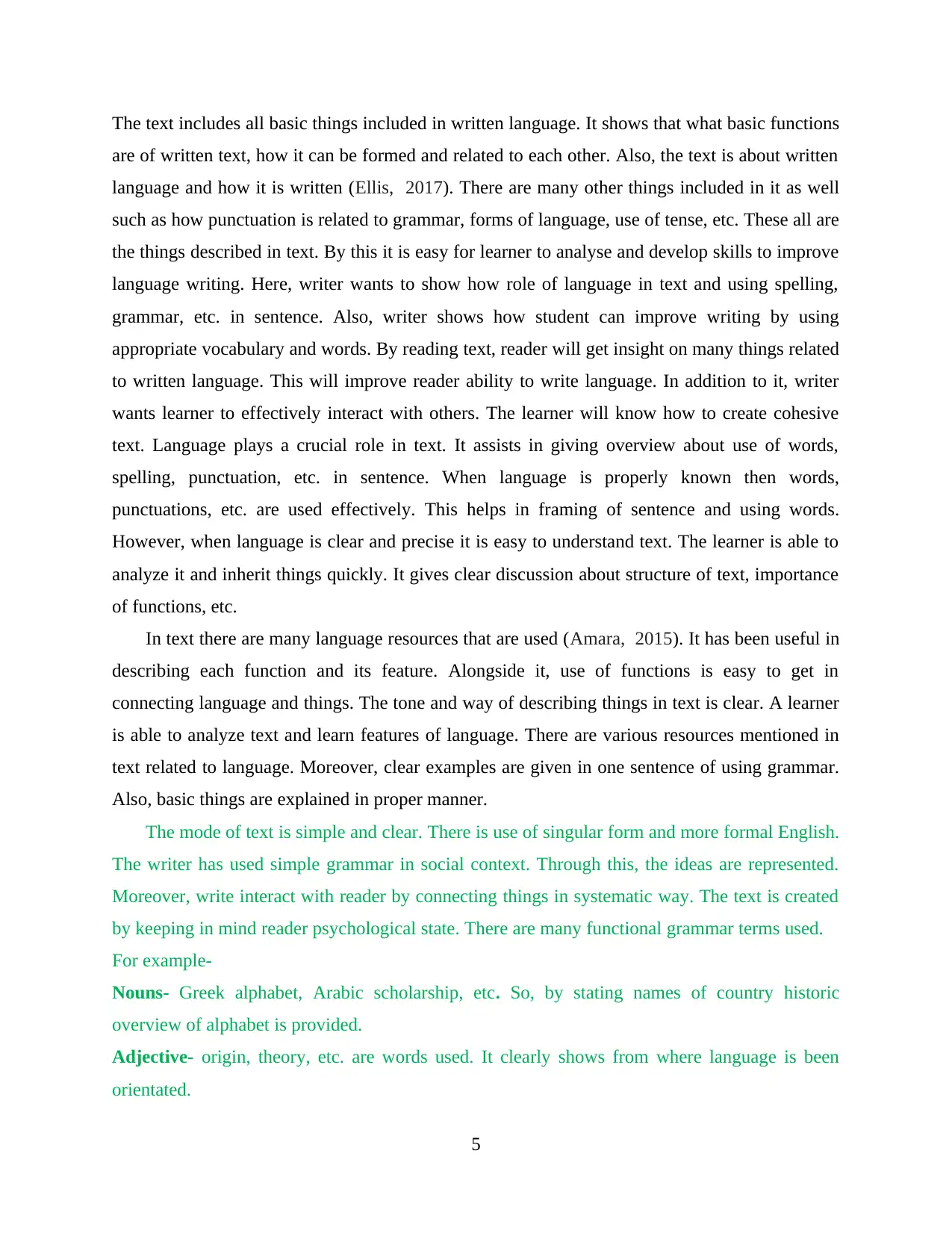
The text includes all basic things included in written language. It shows that what basic functions
are of written text, how it can be formed and related to each other. Also, the text is about written
language and how it is written (Ellis, 2017). There are many other things included in it as well
such as how punctuation is related to grammar, forms of language, use of tense, etc. These all are
the things described in text. By this it is easy for learner to analyse and develop skills to improve
language writing. Here, writer wants to show how role of language in text and using spelling,
grammar, etc. in sentence. Also, writer shows how student can improve writing by using
appropriate vocabulary and words. By reading text, reader will get insight on many things related
to written language. This will improve reader ability to write language. In addition to it, writer
wants learner to effectively interact with others. The learner will know how to create cohesive
text. Language plays a crucial role in text. It assists in giving overview about use of words,
spelling, punctuation, etc. in sentence. When language is properly known then words,
punctuations, etc. are used effectively. This helps in framing of sentence and using words.
However, when language is clear and precise it is easy to understand text. The learner is able to
analyze it and inherit things quickly. It gives clear discussion about structure of text, importance
of functions, etc.
In text there are many language resources that are used (Amara, 2015). It has been useful in
describing each function and its feature. Alongside it, use of functions is easy to get in
connecting language and things. The tone and way of describing things in text is clear. A learner
is able to analyze text and learn features of language. There are various resources mentioned in
text related to language. Moreover, clear examples are given in one sentence of using grammar.
Also, basic things are explained in proper manner.
The mode of text is simple and clear. There is use of singular form and more formal English.
The writer has used simple grammar in social context. Through this, the ideas are represented.
Moreover, write interact with reader by connecting things in systematic way. The text is created
by keeping in mind reader psychological state. There are many functional grammar terms used.
For example-
Nouns- Greek alphabet, Arabic scholarship, etc. So, by stating names of country historic
overview of alphabet is provided.
Adjective- origin, theory, etc. are words used. It clearly shows from where language is been
orientated.
5
are of written text, how it can be formed and related to each other. Also, the text is about written
language and how it is written (Ellis, 2017). There are many other things included in it as well
such as how punctuation is related to grammar, forms of language, use of tense, etc. These all are
the things described in text. By this it is easy for learner to analyse and develop skills to improve
language writing. Here, writer wants to show how role of language in text and using spelling,
grammar, etc. in sentence. Also, writer shows how student can improve writing by using
appropriate vocabulary and words. By reading text, reader will get insight on many things related
to written language. This will improve reader ability to write language. In addition to it, writer
wants learner to effectively interact with others. The learner will know how to create cohesive
text. Language plays a crucial role in text. It assists in giving overview about use of words,
spelling, punctuation, etc. in sentence. When language is properly known then words,
punctuations, etc. are used effectively. This helps in framing of sentence and using words.
However, when language is clear and precise it is easy to understand text. The learner is able to
analyze it and inherit things quickly. It gives clear discussion about structure of text, importance
of functions, etc.
In text there are many language resources that are used (Amara, 2015). It has been useful in
describing each function and its feature. Alongside it, use of functions is easy to get in
connecting language and things. The tone and way of describing things in text is clear. A learner
is able to analyze text and learn features of language. There are various resources mentioned in
text related to language. Moreover, clear examples are given in one sentence of using grammar.
Also, basic things are explained in proper manner.
The mode of text is simple and clear. There is use of singular form and more formal English.
The writer has used simple grammar in social context. Through this, the ideas are represented.
Moreover, write interact with reader by connecting things in systematic way. The text is created
by keeping in mind reader psychological state. There are many functional grammar terms used.
For example-
Nouns- Greek alphabet, Arabic scholarship, etc. So, by stating names of country historic
overview of alphabet is provided.
Adjective- origin, theory, etc. are words used. It clearly shows from where language is been
orientated.
5
Paraphrase This Document
Need a fresh take? Get an instant paraphrase of this document with our AI Paraphraser
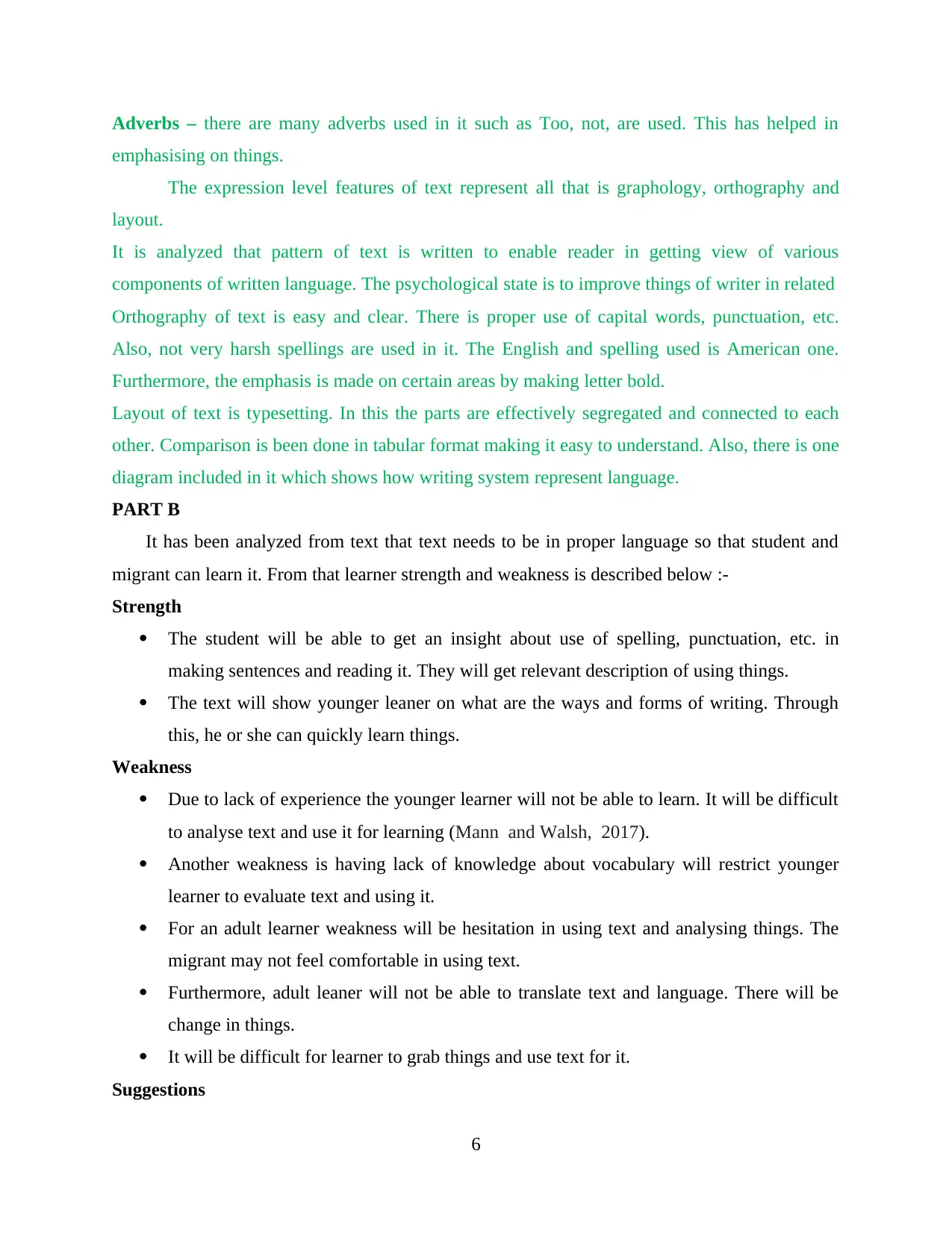
Adverbs – there are many adverbs used in it such as Too, not, are used. This has helped in
emphasising on things.
The expression level features of text represent all that is graphology, orthography and
layout.
It is analyzed that pattern of text is written to enable reader in getting view of various
components of written language. The psychological state is to improve things of writer in related
Orthography of text is easy and clear. There is proper use of capital words, punctuation, etc.
Also, not very harsh spellings are used in it. The English and spelling used is American one.
Furthermore, the emphasis is made on certain areas by making letter bold.
Layout of text is typesetting. In this the parts are effectively segregated and connected to each
other. Comparison is been done in tabular format making it easy to understand. Also, there is one
diagram included in it which shows how writing system represent language.
PART B
It has been analyzed from text that text needs to be in proper language so that student and
migrant can learn it. From that learner strength and weakness is described below :-
Strength
The student will be able to get an insight about use of spelling, punctuation, etc. in
making sentences and reading it. They will get relevant description of using things.
The text will show younger leaner on what are the ways and forms of writing. Through
this, he or she can quickly learn things.
Weakness
Due to lack of experience the younger learner will not be able to learn. It will be difficult
to analyse text and use it for learning (Mann and Walsh, 2017).
Another weakness is having lack of knowledge about vocabulary will restrict younger
learner to evaluate text and using it.
For an adult learner weakness will be hesitation in using text and analysing things. The
migrant may not feel comfortable in using text.
Furthermore, adult leaner will not be able to translate text and language. There will be
change in things.
It will be difficult for learner to grab things and use text for it.
Suggestions
6
emphasising on things.
The expression level features of text represent all that is graphology, orthography and
layout.
It is analyzed that pattern of text is written to enable reader in getting view of various
components of written language. The psychological state is to improve things of writer in related
Orthography of text is easy and clear. There is proper use of capital words, punctuation, etc.
Also, not very harsh spellings are used in it. The English and spelling used is American one.
Furthermore, the emphasis is made on certain areas by making letter bold.
Layout of text is typesetting. In this the parts are effectively segregated and connected to each
other. Comparison is been done in tabular format making it easy to understand. Also, there is one
diagram included in it which shows how writing system represent language.
PART B
It has been analyzed from text that text needs to be in proper language so that student and
migrant can learn it. From that learner strength and weakness is described below :-
Strength
The student will be able to get an insight about use of spelling, punctuation, etc. in
making sentences and reading it. They will get relevant description of using things.
The text will show younger leaner on what are the ways and forms of writing. Through
this, he or she can quickly learn things.
Weakness
Due to lack of experience the younger learner will not be able to learn. It will be difficult
to analyse text and use it for learning (Mann and Walsh, 2017).
Another weakness is having lack of knowledge about vocabulary will restrict younger
learner to evaluate text and using it.
For an adult learner weakness will be hesitation in using text and analysing things. The
migrant may not feel comfortable in using text.
Furthermore, adult leaner will not be able to translate text and language. There will be
change in things.
It will be difficult for learner to grab things and use text for it.
Suggestions
6
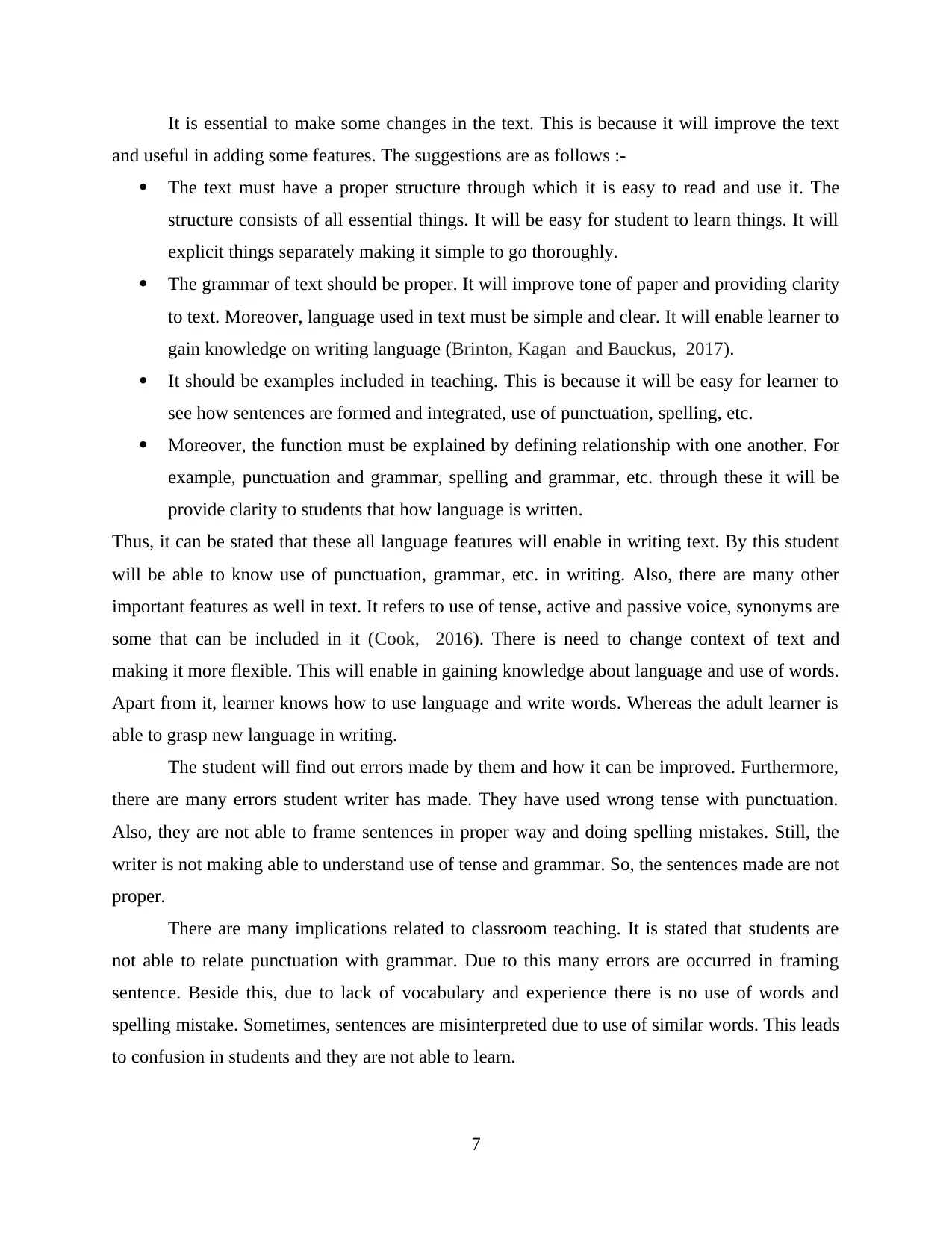
It is essential to make some changes in the text. This is because it will improve the text
and useful in adding some features. The suggestions are as follows :-
The text must have a proper structure through which it is easy to read and use it. The
structure consists of all essential things. It will be easy for student to learn things. It will
explicit things separately making it simple to go thoroughly.
The grammar of text should be proper. It will improve tone of paper and providing clarity
to text. Moreover, language used in text must be simple and clear. It will enable learner to
gain knowledge on writing language (Brinton, Kagan and Bauckus, 2017).
It should be examples included in teaching. This is because it will be easy for learner to
see how sentences are formed and integrated, use of punctuation, spelling, etc.
Moreover, the function must be explained by defining relationship with one another. For
example, punctuation and grammar, spelling and grammar, etc. through these it will be
provide clarity to students that how language is written.
Thus, it can be stated that these all language features will enable in writing text. By this student
will be able to know use of punctuation, grammar, etc. in writing. Also, there are many other
important features as well in text. It refers to use of tense, active and passive voice, synonyms are
some that can be included in it (Cook, 2016). There is need to change context of text and
making it more flexible. This will enable in gaining knowledge about language and use of words.
Apart from it, learner knows how to use language and write words. Whereas the adult learner is
able to grasp new language in writing.
The student will find out errors made by them and how it can be improved. Furthermore,
there are many errors student writer has made. They have used wrong tense with punctuation.
Also, they are not able to frame sentences in proper way and doing spelling mistakes. Still, the
writer is not making able to understand use of tense and grammar. So, the sentences made are not
proper.
There are many implications related to classroom teaching. It is stated that students are
not able to relate punctuation with grammar. Due to this many errors are occurred in framing
sentence. Beside this, due to lack of vocabulary and experience there is no use of words and
spelling mistake. Sometimes, sentences are misinterpreted due to use of similar words. This leads
to confusion in students and they are not able to learn.
7
and useful in adding some features. The suggestions are as follows :-
The text must have a proper structure through which it is easy to read and use it. The
structure consists of all essential things. It will be easy for student to learn things. It will
explicit things separately making it simple to go thoroughly.
The grammar of text should be proper. It will improve tone of paper and providing clarity
to text. Moreover, language used in text must be simple and clear. It will enable learner to
gain knowledge on writing language (Brinton, Kagan and Bauckus, 2017).
It should be examples included in teaching. This is because it will be easy for learner to
see how sentences are formed and integrated, use of punctuation, spelling, etc.
Moreover, the function must be explained by defining relationship with one another. For
example, punctuation and grammar, spelling and grammar, etc. through these it will be
provide clarity to students that how language is written.
Thus, it can be stated that these all language features will enable in writing text. By this student
will be able to know use of punctuation, grammar, etc. in writing. Also, there are many other
important features as well in text. It refers to use of tense, active and passive voice, synonyms are
some that can be included in it (Cook, 2016). There is need to change context of text and
making it more flexible. This will enable in gaining knowledge about language and use of words.
Apart from it, learner knows how to use language and write words. Whereas the adult learner is
able to grasp new language in writing.
The student will find out errors made by them and how it can be improved. Furthermore,
there are many errors student writer has made. They have used wrong tense with punctuation.
Also, they are not able to frame sentences in proper way and doing spelling mistakes. Still, the
writer is not making able to understand use of tense and grammar. So, the sentences made are not
proper.
There are many implications related to classroom teaching. It is stated that students are
not able to relate punctuation with grammar. Due to this many errors are occurred in framing
sentence. Beside this, due to lack of vocabulary and experience there is no use of words and
spelling mistake. Sometimes, sentences are misinterpreted due to use of similar words. This leads
to confusion in students and they are not able to learn.
7
⊘ This is a preview!⊘
Do you want full access?
Subscribe today to unlock all pages.

Trusted by 1+ million students worldwide
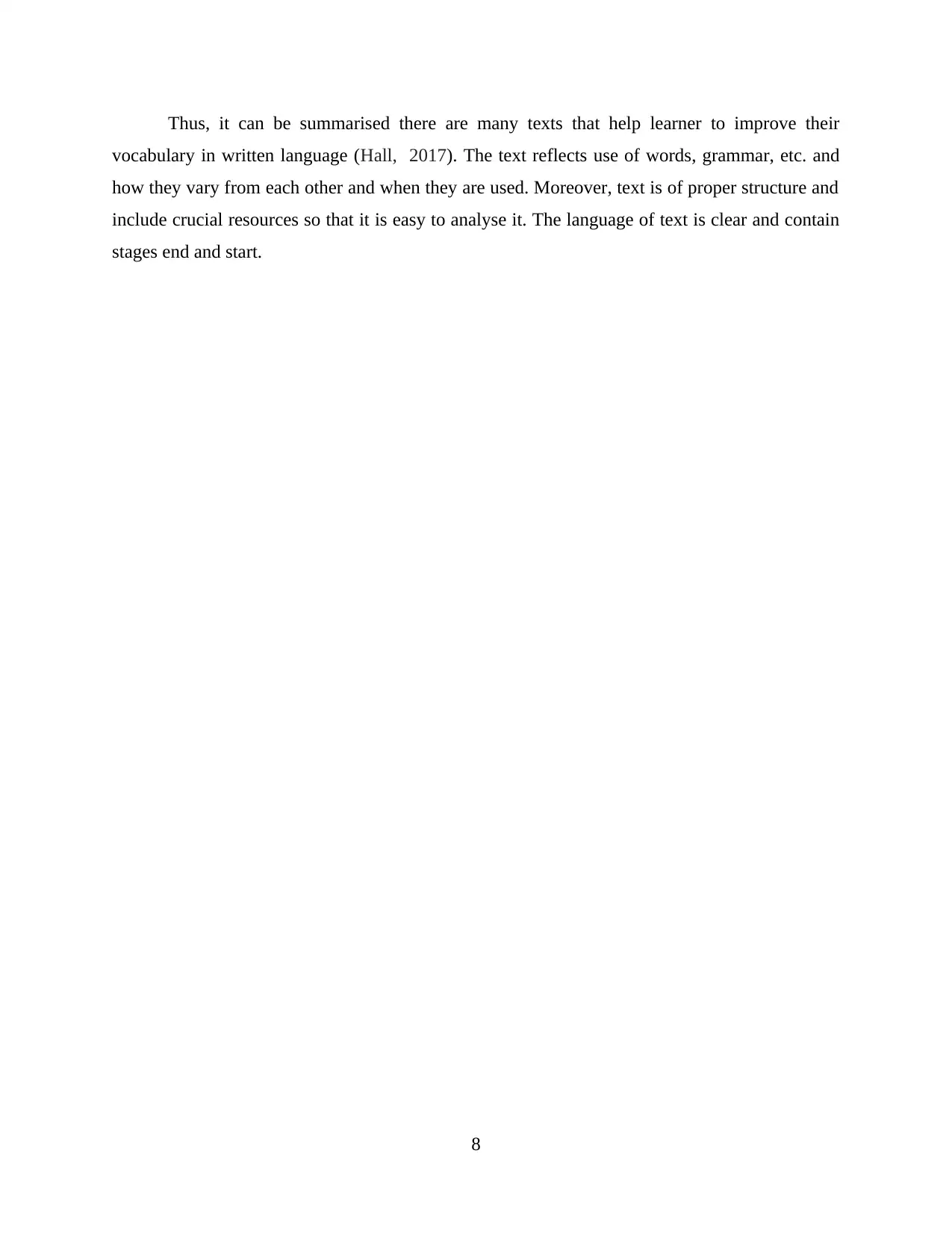
Thus, it can be summarised there are many texts that help learner to improve their
vocabulary in written language (Hall, 2017). The text reflects use of words, grammar, etc. and
how they vary from each other and when they are used. Moreover, text is of proper structure and
include crucial resources so that it is easy to analyse it. The language of text is clear and contain
stages end and start.
8
vocabulary in written language (Hall, 2017). The text reflects use of words, grammar, etc. and
how they vary from each other and when they are used. Moreover, text is of proper structure and
include crucial resources so that it is easy to analyse it. The language of text is clear and contain
stages end and start.
8
Paraphrase This Document
Need a fresh take? Get an instant paraphrase of this document with our AI Paraphraser
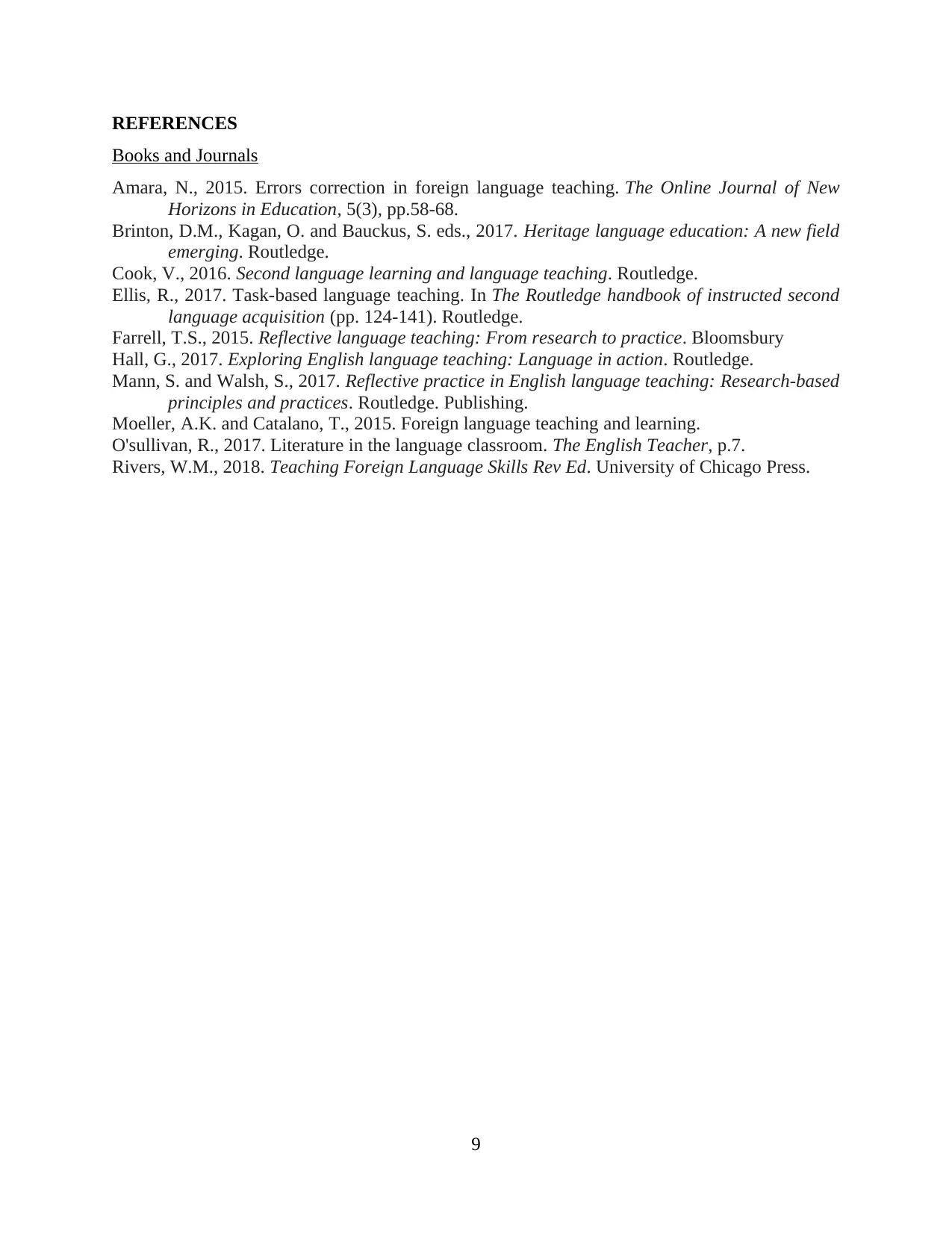
REFERENCES
Books and Journals
Amara, N., 2015. Errors correction in foreign language teaching. The Online Journal of New
Horizons in Education, 5(3), pp.58-68.
Brinton, D.M., Kagan, O. and Bauckus, S. eds., 2017. Heritage language education: A new field
emerging. Routledge.
Cook, V., 2016. Second language learning and language teaching. Routledge.
Ellis, R., 2017. Task-based language teaching. In The Routledge handbook of instructed second
language acquisition (pp. 124-141). Routledge.
Farrell, T.S., 2015. Reflective language teaching: From research to practice. Bloomsbury
Hall, G., 2017. Exploring English language teaching: Language in action. Routledge.
Mann, S. and Walsh, S., 2017. Reflective practice in English language teaching: Research-based
principles and practices. Routledge. Publishing.
Moeller, A.K. and Catalano, T., 2015. Foreign language teaching and learning.
O'sullivan, R., 2017. Literature in the language classroom. The English Teacher, p.7.
Rivers, W.M., 2018. Teaching Foreign Language Skills Rev Ed. University of Chicago Press.
9
Books and Journals
Amara, N., 2015. Errors correction in foreign language teaching. The Online Journal of New
Horizons in Education, 5(3), pp.58-68.
Brinton, D.M., Kagan, O. and Bauckus, S. eds., 2017. Heritage language education: A new field
emerging. Routledge.
Cook, V., 2016. Second language learning and language teaching. Routledge.
Ellis, R., 2017. Task-based language teaching. In The Routledge handbook of instructed second
language acquisition (pp. 124-141). Routledge.
Farrell, T.S., 2015. Reflective language teaching: From research to practice. Bloomsbury
Hall, G., 2017. Exploring English language teaching: Language in action. Routledge.
Mann, S. and Walsh, S., 2017. Reflective practice in English language teaching: Research-based
principles and practices. Routledge. Publishing.
Moeller, A.K. and Catalano, T., 2015. Foreign language teaching and learning.
O'sullivan, R., 2017. Literature in the language classroom. The English Teacher, p.7.
Rivers, W.M., 2018. Teaching Foreign Language Skills Rev Ed. University of Chicago Press.
9
1 out of 11
Related Documents
Your All-in-One AI-Powered Toolkit for Academic Success.
+13062052269
info@desklib.com
Available 24*7 on WhatsApp / Email
![[object Object]](/_next/static/media/star-bottom.7253800d.svg)
Unlock your academic potential
Copyright © 2020–2025 A2Z Services. All Rights Reserved. Developed and managed by ZUCOL.





